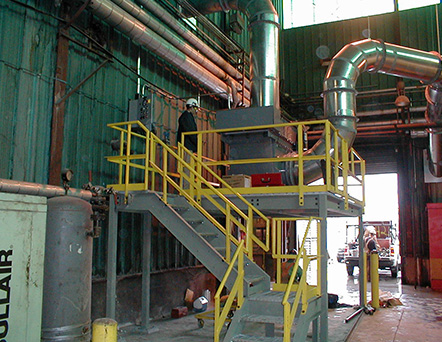
Background
Fortune 500 chemical company has a plant that produces, among other products, hydrocarbon resins for use in assembly, automotive, building and construction, lamination, adhesive and other applications. During the production process, resin ingredients are mixed, heated, and distributed onto a water-cooled belt. As the hot liquid resin encounters the cool belt, hydrocarbon vapors are released, and then quickly condense to create a fine, white oil mist rising from the process.
At this plant, the mist was controlled with a venturi scrubber that was approaching the end of its useful life. The venturi scrubber had never provided high control efficiency for the mist, resulting in visible emissions from the stack – near the plant’s 20% opacity limit – and extensive black emission stains on nearby equipment and the adjacent building. Further, the sticky resins that passed through the venturi scrubber would foul the exhaust fan, causing unscheduled downtime for the ventilation system and production line. The plant engineering group’s objective was to find a unit to replace the scrubber that:
Comparison of Alternatives
Alternatives for fine oil mist control include the following technologies:
Candle-type and coalescing bed type filters can provide high-efficiency control of the oil mist, but do not work effectively if any solid particulate matter is also present, or if the oil mist has a sticky nature, both of which were the case in this application. Both solid and sticky particulate blinds the filter (or any pre-filters), choking off air from the process quickly, and/or causing channeling/bypass or premature change-out of the filter media. As such this option was dismissed.
The wet ESP has an exceptionally high capital cost and was dismissed because of this.
The technologies seriously considered included a venturi scrubber, catalytic and thermal oxidizers, and the UHF® filter. The technologies compared technically and economically as shown in the table below. Electrical energy and natural gas unit costs were $0.05/kWh and $7/MMBTU, respectively.
Summary Comparison of Emission Control Technologies, Resin Production Line
| Venturi Scrubber | Catalytic Oxidizer | Thermal Oxidizer | UHF Filter | |
| Fan Motor BHP | 75 | 75 | 50 | 50 |
| Electr. energy Cost1 | $24K/yr | $24K/yr | $16K/yr | $16K/yr |
| Nat. Gas Cost | – | $108K/yr | $354K/yr | – |
| Mat’ls & Other Cost | $24K/yr | $140K/yr | $370K/yr | $20K/yr |
| Total Operating Cost | $71/yr | $438K/yr | $55K/yr | |
| Capital Equipment Cost | $75K | $175K | $175K | $70K |
| Control Efficiency | -70% | 97%+ | 99%+ | 98-99% |
| Uptime | 80-90% | 90-95% | 95-99% | |
| Product Recovery | Yes | No | No | Yes |
The venturi scrubber presented multiple problems as the company had already experienced, mainly very low control efficiency (i.e., approximately 70%) on the primarily submicron mist droplets (or conversely requiring a pressure drop on the order of 40”+ w.g. to effectively control submicron sizes, i.e., extremely high energy costs), and also results in a water treatment/disposal issue.
Catalytic and thermal oxidizers were dismissed as the air stream was dilute and required high natural gas costs for the large volume of air.
The UHF® filter system offered a control efficiency of up to 99%, simultaneously removed solid and liquid particulate matter without any operational problem at all, offered very simple and reliable operation, with no downtime required for filter replacement. It offered these features at the lowest capital and operating cost of all the options.
Decision and Result
A UHF® filter unit for 15,000 ACFM was selected and installed. Results include elimination of all visible emissions, no unscheduled downtime, and no black resin stains on assets around the stack. The success of the project led one of the engineering firm staff to ask and comment “Where has this UHF® filter product been? We wish we had known of the product earlier, before installing other venturi scrubbers in the plant over the past few years.”